Excerpts from Jim Conrad's
Naturalist Newsletter
Entry issued on May 20, 2019, from Tepakán, Yucatán, MÉXICO
YUCATAN SALAMANDER
In 2017 we found an salamander near Ek Balam {next entry} so obscurely marked that I never was sure which species it was. This week a boldly patterned one turned up and now I'm fairly certain that both of our encounters have been with the Yucatan Salamander, BOLITOGLOSSA YUCATANA. This week's individual is shown below:
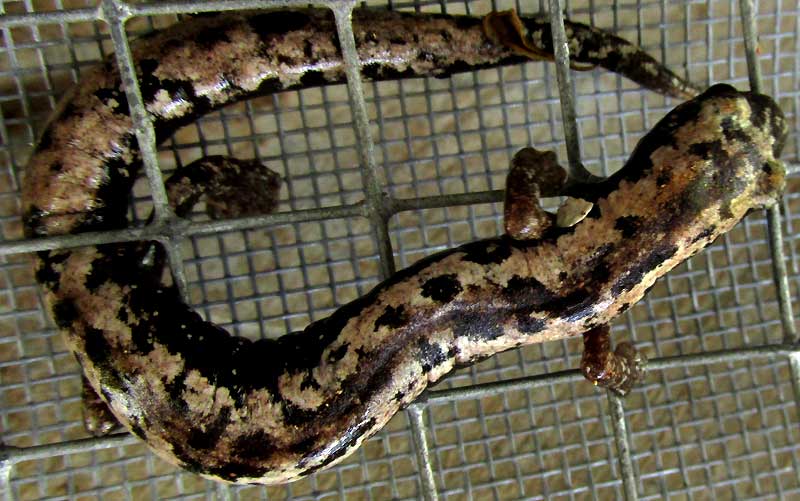
The salamander is on wire netting spread atop an old well head to keep things out of the well. The windmill had been spilling water there for several days, and this was enough to convince the salamander that the rainy season had arrived, which it hasn't quite. This was a larger individual than the one profiled below. For scale, the wires in the larger mesh screen are 12mm apart (nearly ½inch). When I moved in for a closer shot of head features, he moved below the large-mesh screen, as seen below:
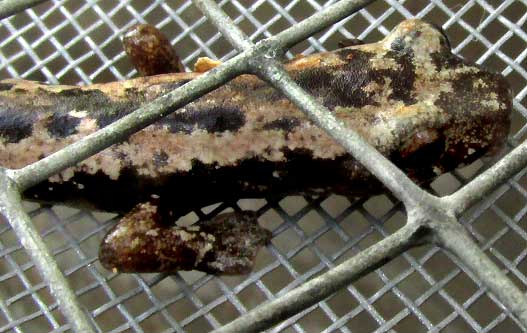
Note that the hands are webbed between the fingers. Below, a shot of the rear end shows an important feature:
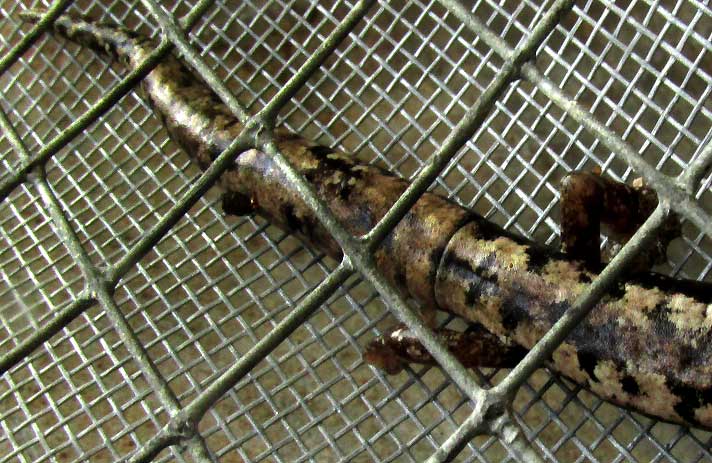
Notice the joint-like feature behind the legs, and that immediately behind the joint the tail is thicker than the body before the joint. The thick tail is an adaptive feature enabling the Yucatan Salamander to survive in arid northern Yucatan. It stores fat and water.
Another interesting feature of our Yucatan Salamander, not already addressed in the following entry, is that it belongs to the salamander family Plethodontidae, so it has no lungs at all. It breathes entirely through its skin and the lining of its mouth. Also interesting is how these salamanders climb wet vertical surfaces using suction created by placement of their feet. While a foot's outside margins adheres to the substrate, the central part of the foot is lifted, causing suction, keeping the foot in place just as a wet bathroom plunger holds onto a smooth floor when its handle is pulled.
Yucatan Salamanders are endemic only to the northern and eastern Yucatan Peninsula, with an island or disjunct population farther south in the Calakmul area, and a smaller population around Chetumal and northern Belize.
Entry issued on April 15, 2020, from Tepakán, Yucatán, MÉXICO
A SLIGHTLY DIFFERENT PATTERN
In the midst of an exceptionally hot, rainless dry season the Yucatan Salamander shown below turned up in a pan kept filled for watering birds. It was atop a low cinderblock wall beside the hut, and one wonders at the journey the little fellow made to get there.
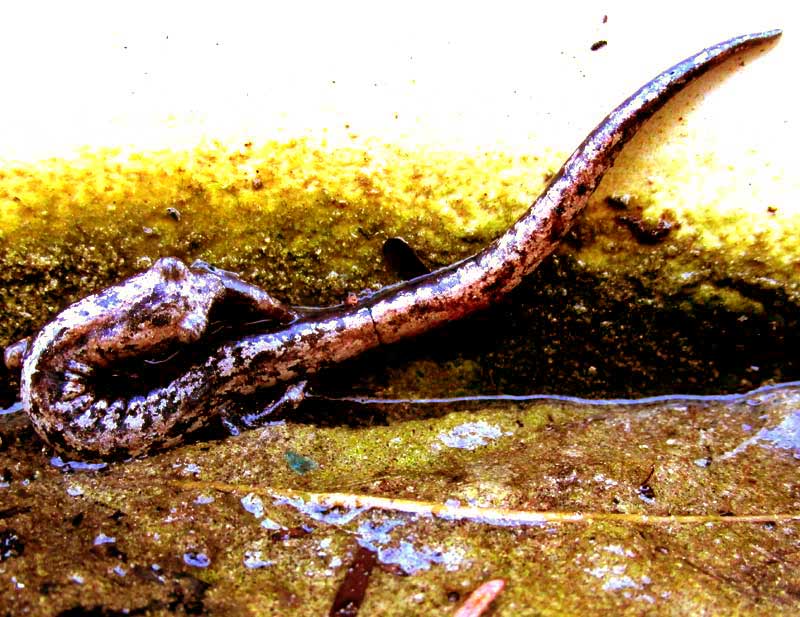
from the October 29, 2017 Newsletter issued from Rancho Regenesis in the woods ±4kms west of Ek Balam Ruins; elevation ~40m (~130 ft), N20.876°, W88.170°; north-central Yucatán, MÉXICO
A HARD-TO-IDENTIFY SALAMANDER
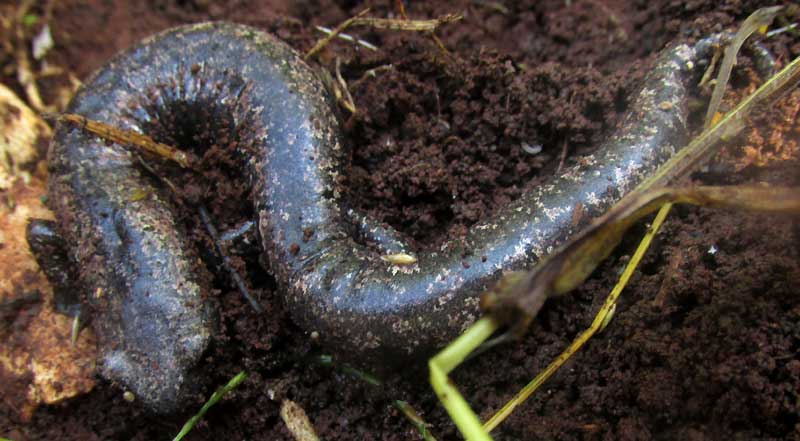
The Yucatan is poor salamander-hunting ground because the climate is too arid; salamanders need moist environments. Farther south in Chiapas, Belize and Guatemala a handful of salamander species turn up, but according to distribution descriptions in Jonathan Campbell's Amphibians and Reptiles of Northern Guatemala, the Yucatán, and Belize, only two salamander species might appear in the northern Yucatan, and he doesn't describe one of them.
So, after two weeks of absence during the late rainy season, when plants grow at their absolute lustiest, I was hacking my way through the garden, hoping to enforce some order. The tall grass was wet despite no rain having fallen for 48 hours. Imagine my surprise when my hoe took down a big clump of Tropical Panicgrass, and there on the black, sodden soil where the grass had stood lay the salamander shown at the top of this page.
Expecting the little critter to bolt at any moment, I was surprised to get that picture. However, he didn't move at all, until I got into position for a second photo, which shows nothing extra, but which I provide here just because this is such a special sighting. The superfluous image appears below:
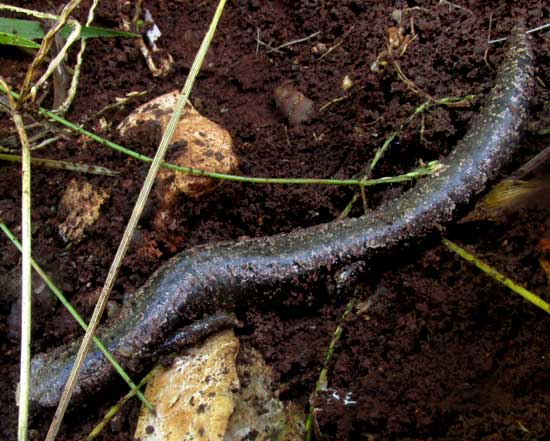
Actually, the little fellow acted a little stunned. Maybe the hoe had jostled him around, or maybe the coolish air -- at 62° (17°C) it was the chilliest morning we've had since maybe early March or so -- made him sluggish. Whatever the cause, he gave me time for a shot at his pensive-looking face, shown below:
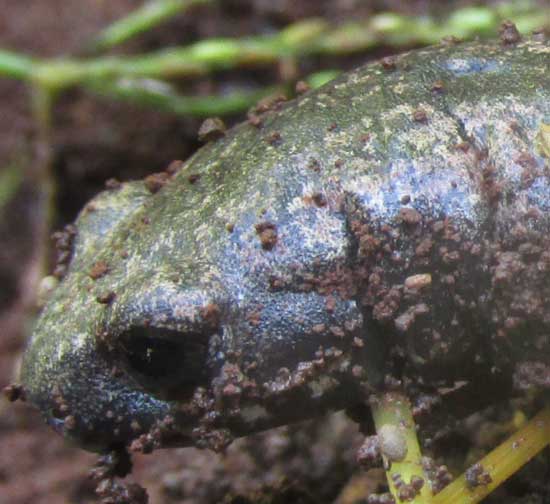
Then he moved away, and I didn't feel right pestering him any more for more pictures.
Despite so few species possibly occurring in the northern Yucatan, I'm uncertain which species this is. However, this salamander's appearance in our shaggy garden is the most exciting observations I've made in a long time.